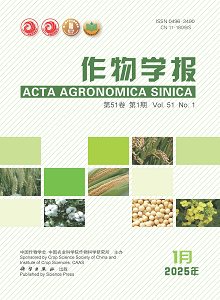基于染色体片段代换系的水稻植株结构QTL定位
引用次数: 0
摘要
:植株构型是多种形态和生理性状综合的复合性状,与水稻产量密切相关。破译优秀的植株结构等位基因或qtl对水稻高产育种具有重要意义。本研究在实验室构建了一套长恢121/Koshihikari染色体片段代换系(CSSLs),大小为208。在3种环境下检测到控制株高、旗叶形态和分蘖数的qtl。除第9染色体外,在11条染色体上共鉴定出35个水稻结构qtl,表型变异解释范围为2.00% ~ 22.86%。值得注意的是,qPH-1-1、qFLW-6和qFLA-3在3种环境中均能检测到,其中qFLW-6是新鉴定的旗叶宽度QTL。通过携带qPH-1-1和位点的替代系进行表型鉴定,验证了两个位点等位基因的加性效应和环境稳定性。该研究结果为水稻植株结构qtl的精细定位和克隆以及水稻育种中的分子标记辅助选择(MAS)奠定了基础。本文章由计算机程序翻译,如有差异,请以英文原文为准。
QTL mapping for plant architecture in rice based on chromosome segment substitution lines
: Plant architecture is a compound trait integrated with multiple morphological and physiological traits, and it is closely related to rice yield. Deciphering excellent plant architecture alleles or QTLs is of great significance for high-yield rice breeding. In this study, we constructed a set of Changhui 121/Koshihikari chromosome segment substitution lines (CSSLs) with the size of 208 in our laboratory. QTLs controlling plant height, flag leaf morphology, and tiller numbers were detected under three environments. A total of 35 QTLs for rice architecture were identified on 11 chromosomes except chromosome 9, and the range of the phenotypic variation explaining was 2.00%–22.86%. It was worth noting that qPH-1-1 , qFLW-6 , and qFLA-3 could be detected in three environments, among which qFLW-6 was a newly identified QTL of the flag leaf width. Phenotypic identification verified that the additive effects and environmental stability of the two locus alleles by the replacement lines carrying qPH-1-1 and sites. The results of this study laid the foundation for further fine mapping and cloning of QTLs for rice plant architecture and the molecular marker-assisted selection (MAS) in rice breeding.
求助全文
通过发布文献求助,成功后即可免费获取论文全文。
去求助
来源期刊

作物学报
Agricultural and Biological Sciences-Agronomy and Crop Science
CiteScore
1.70
自引率
0.00%
发文量
89
期刊介绍:
The major aims of AAS are to report the progresses in the disciplines of crop breeding, crop genetics, crop cultivation, crop physiology, ecology, biochemistry, germplasm resources, grain chemistry, grain storage and processing, bio-technology and biomathematics etc. mainly in China and abroad. AAS provides regular columns for Original papers, Reviews, and Research notes. The strict peer-review procedure guarantees the academic level and raises the reputation of the journal. The readership of AAS is for crop science researchers, students of agricultural colleges and universities, and persons with similar academic level.
 求助内容:
求助内容: 应助结果提醒方式:
应助结果提醒方式:


